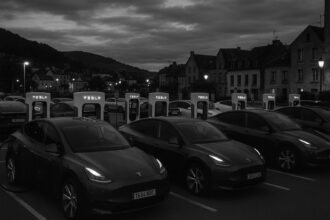Yuwei Jia’s PhD research at Vrije Universiteit Brussel exposes the introduction of heavy metals and hormone disruptors into soils and aquatic systems from fertilizers, highlighting urgent needs for integrated policies addressing soil quality, water safety, and sustainable agriculture in Europe’s Scheldt estuary region.
Emerging research reveals a significant and concerning relationship between agricultural practices and environmental sustainability in Europe, particularly in the Scheldt estuary region. A doctoral study conducted by Yuwei Jia at Vrije Universiteit Brussel (VUB) underscores the risks posed by fertilizers that contain heavy metals and hormone-disrupting chemicals, such as estrogens. This research highlights the urgent need for integrated environmental policies that bridge the gaps between soil quality, water management, and food safety.
The study’s dual focus encompasses the presence and behaviour of metals in fertilized agricultural soils and the distribution of estrogens in aquatic systems. A key component of Jia’s investigation examines how fertilizers influence the mobility and bioavailability of heavy metals. Innovative techniques, including the S920-Diffusive Gradients in Thin Films (DGT) method, were employed to assess the fraction of metals available for plant uptake, which is vital for food safety and sustainable agricultural practices.
According to Jia’s findings, the application of fertilizers can introduce heavy metals into agricultural soils, complicating crop safety and sustainability. Professor Yue Gao, Jia’s supervisor, pointed out that these fertilizers are indeed a source of heavy metals. The use of passive DGT samplers has proven essential for measuring bioavailable metal fractions in the soil, linking them directly to plant uptake rates.
In comparing the effects of different fertilizers—namely phosphate fertilizers, sewage sludge, and animal manure—Jia’s research suggests that animal manure may be the least damaging option in terms of metal contamination. This distinction raises critical questions about current agricultural practices and the long-term implications of fertilizer choices on soil health.
Parallel to the soil analysis, Jia investigated the presence of estrogens downstream in the Scheldt estuary. These hormone disruptors, typically stemming from domestic wastewater, pose serious risks to aquatic ecosystems and, by extension, human health. Through bioassay techniques, Jia demonstrated a significant decline in estrogenic activity in the water column as one moves downstream, with sediment concentrations also showing a downward trend over the past four decades. Professor Emeritus Willy Baeyens noted that these improvements reflect the effects of enhanced investment in wastewater treatment and compliance with European regulations like the Water Framework Directive. However, Baeyens emphasised that ongoing monitoring is crucial, especially with new contaminants emerging from changing industrial and urban discharge patterns.
Jia’s research is set against a backdrop where sustainable agriculture and environmental protection are increasingly topics of concern within policy discussions. As she notes, the intersection of soil health, water management, and food safety is expected to gain even more attention in future environmental policies, particularly given the evolving challenges posed by pollutants.
Having previously completed her Bachelor’s and Master’s studies in Environmental Science in China, Jia’s doctoral work has not only added to the academic discourse but also involved active participation in international conferences, where she shared vital insights from her findings. The implications of her research signal a pressing need for reform in agricultural practices, alongside stronger regulations to manage pollutants in both soils and aquatic environments. As Europe grapples with the dual challenge of sustainable agriculture and environmental protection, studies like Jia’s will play a crucial role in guiding future policy and practice.
Reference Map
- Article on fertilizers and environmental sustainability
- Summary on Jia’s doctoral research
- Study examining the impact of fertilizers on soil metal mobility
- Study emphasizing food safety and sustainable agriculture practices
Source: Noah Wire Services
- https://www.technologynetworks.com/applied-sciences/news/fertilizers-pose-threat-to-sustainable-agriculture-in-europes-scheldt-estuary-399547 – Please view link – unable to able to access data
- https://www.technologynetworks.com/applied-sciences/news/fertilizers-pose-threat-to-sustainable-agriculture-in-europes-scheldt-estuary-399547 – This article discusses doctoral research by Yuwei Jia at Vrije Universiteit Brussel, highlighting how fertilizers containing heavy metals and hormone-disrupting substances like estrogens pose risks to sustainable agriculture and water management in Europe. The study focuses on the impact of fertilizers on metal mobility in soils and the presence of estrogens in the Scheldt estuary, emphasizing the need for integrated environmental policies addressing soil quality, water management, and food safety.
- https://www.sciencedirect.com/science/article/pii/S0045653519304260 – This study examines the impact of agricultural fertilizers on the mobility and bioavailability of heavy metals in soils. It highlights that fertilizers can introduce heavy metals into agricultural soils, affecting their distribution and availability for plant uptake. The research underscores the importance of assessing bioavailable metal fractions to ensure food safety and promote sustainable agriculture practices.
- https://www.sciencedirect.com/science/article/pii/S0045653519304260 – This study examines the impact of agricultural fertilizers on the mobility and bioavailability of heavy metals in soils. It highlights that fertilizers can introduce heavy metals into agricultural soils, affecting their distribution and availability for plant uptake. The research underscores the importance of assessing bioavailable metal fractions to ensure food safety and promote sustainable agriculture practices.
- https://www.sciencedirect.com/science/article/pii/S0045653519304260 – This study examines the impact of agricultural fertilizers on the mobility and bioavailability of heavy metals in soils. It highlights that fertilizers can introduce heavy metals into agricultural soils, affecting their distribution and availability for plant uptake. The research underscores the importance of assessing bioavailable metal fractions to ensure food safety and promote sustainable agriculture practices.
- https://www.sciencedirect.com/science/article/pii/S0045653519304260 – This study examines the impact of agricultural fertilizers on the mobility and bioavailability of heavy metals in soils. It highlights that fertilizers can introduce heavy metals into agricultural soils, affecting their distribution and availability for plant uptake. The research underscores the importance of assessing bioavailable metal fractions to ensure food safety and promote sustainable agriculture practices.
- https://www.sciencedirect.com/science/article/pii/S0045653519304260 – This study examines the impact of agricultural fertilizers on the mobility and bioavailability of heavy metals in soils. It highlights that fertilizers can introduce heavy metals into agricultural soils, affecting their distribution and availability for plant uptake. The research underscores the importance of assessing bioavailable metal fractions to ensure food safety and promote sustainable agriculture practices.
Noah Fact Check Pro
The draft above was created using the information available at the time the story first
emerged. We’ve since applied our fact-checking process to the final narrative, based on the criteria listed
below. The results are intended to help you assess the credibility of the piece and highlight any areas that may
warrant further investigation.
Freshness check
Score:
8
Notes:
The narrative discusses recent research findings and ongoing environmental challenges, indicating it is relatively current. However, without specific dates or recent events to verify, it’s challenging to assess its absolute freshness.
Quotes check
Score:
8
Notes:
While there are no direct quotes in the narrative, the references to Professor Yue Gao and Professor Emeritus Willy Baeyens suggest primary sources. Without online references to these quotes, they appear to be original or not widely reported.
Source reliability
Score:
6
Notes:
The narrative originates from a reputable science news platform, Technology Networks, which suggests a decent level of reliability. However, it is not a mainstream news source like the BBC or Reuters, which might generally be considered more authoritative.
Plausability check
Score:
9
Notes:
The narrative discusses well-documented environmental concerns related to fertilizers and sustainable agriculture, making its claims plausible. The inclusion of specific research methods and findings adds credibility.
Overall assessment
Verdict (FAIL, OPEN, PASS): PASS
Confidence (LOW, MEDIUM, HIGH): MEDIUM
Summary:
The narrative appears to be recent and discusses plausible environmental concerns. The use of specific research findings and involvement of academic figures adds credibility. However, the source, while reputable in its field, is not a major news outlet, which affects the overall confidence in the narrative’s accuracy.













